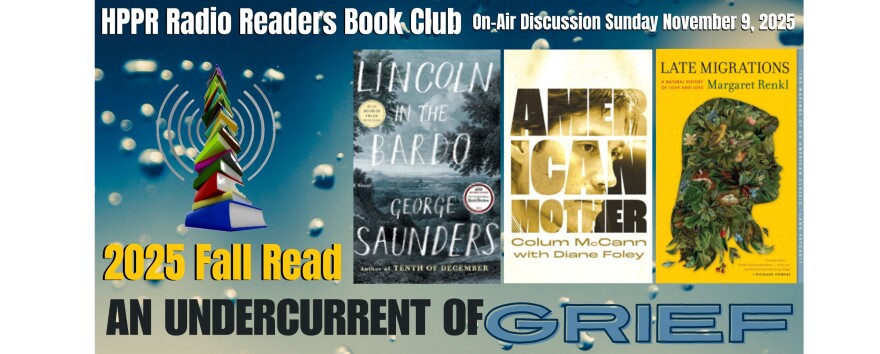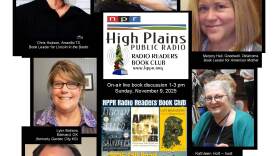Hi there. I’m Jenny Inzerillo, HPPR’s Music Director and host for High Plains Morning.
Today, for HPPR Radio Readers Book Club, I’m going to review the fourth book in the Spring Read. The full title is Hyperbole and a Half: Unfortunate Situations, Flawed Coping Mechanisms, Mayhem, and Other Things That Happened, by beloved underground blogger Allie Brosh.
Before I share my impressions of the book, I thought I’d give you a taste of the author’s wit and humor. Here’s the back cover, ostensibly to help sell the book. It reads:
“This is a book I wrote. Because I wrote it, I had to figure out what to put on the back cover to explain what it is. I tried to write a long, third-person summary that would imply how great the book is and also sound vaguely authoritative--like maybe someone who isn’t me wrote it--but I soon discovered that I’m not sneaky enough to pull it off convincingly. So, I decided to just make a list of things that are in the book:
Pictures
Words
Stories about things that happened to me
Stories about things that happened to other people because of me
Eight billion dollars*
Stories about dogs
The secret to eternal happiness*
*These are lies. Perhaps I have underestimated my sneakiness!”
I think that back cover copy lays it down that this disjointed autobiography doesn’t try to be anything it’s not. The author is direct, honest, and delightfully self-deprecating in a way many of her readers can relate to. And since it’s a graphic novel -- think “elevated comic book” – you also get to see what she’s explaining, and Brosh’s drawings often communicate much more than her words do. Now here’s where a lot of readers might be weirded out: the illustrations. She renders every story in her rudimentary digital style, so the frames look like a rush-job in Microsoft Paint or Mac Paintbrush (which is indeed where she creates them). And when I say “rudimentary,” think distracted kindergartener.
We’re talking Your-Memaw-Could-Illustrate-These-On-A-Commodore-64-level basic. But once you get into it, that’s the charm of her illustration. The pics are simple, but they pack a lot of emotion into a few squiggly lines. And if you’re an artist, you know how difficult that can be. (And once in a while she’ll put up an incredible frame that proves her talent goes far beyond her default scribbles-of-choice.)
This author first came to my attention from her online blog, which shares a name with the book: “Hyperbole and a Half.” The blog was born in 2009, a time of true blog excellence (if you were paying attention to the rise of American youth sharing their inner lives on the internet); for context, this was the year that MySpace become cannibalized by Facebook. If I remember correctly from my time living in Chicago, working a desk job at a publishing house, zoning out on breaks by hunting down funny writers like Brosh, I think she uploaded a now-famous post about her rescue dogs that was so hilarious that it went viral, circulated widely pretty quickly until her name was really “out there.”
So she then had a following – people who anticipated her posts and paid close attention when she posted “Adventures in Depression” in October 2011 and then went silent for over a year. Messages of support poured in, people concerned about her safety – but by 2013, she had clawed her way out of her mental health crisis, finished this book, and ushered in what might be the most bizarre and striking conversation about clinical depression in existence.
Although it’s packed with humorous anecdotes about what a freak she was as a kid, a rogue goose home invasion, and her poorly behaved pets, the heavy stuff is where this novel shines. Any perfunctory search for reviews of this book online will reveal how spectacularly Brosh unpacks the fundamentals of mental illness. And yes, she even manages to make a scene where she’s admitting to her mom that she’s been thinking about self-harm FUNNY. It’s one of those things that you really just have to experience, because her images fill in so much here. But I want to talk about the chapter titled “Depression: Part Two,” which was one of the original blog posts before she went radio silent for a year. In it, she explains the disconnect between a person experiencing clinical depression and the attempt at intervention by friends and family simply trying to help.
In the first frame, you see a woman asking, “What’s wrong?”
Brosh replies, “My fish are dead.” Flat expression on her face, and a dead goldfish in each hand.
The woman, jubilant, replies “Don’t worry! I’ll help you find them! Are there any clues where they went?”
Brosh, confused, replies, “I know where there are. The problem is they aren’t alive anymore.”
The woman, still smiling, says “Let’s keep looking! I’m sure they’ll turn up somewhere.”
Hopelessly resigned to not being understood, Brosh utters, “No, see, that solution is for a different problem than the one I have.”
She then shifts to an internal thought: “The problem might not even have a solution. But you aren't necessarily looking for solutions. You're maybe just looking for someone to say "sorry about how dead your fish are" or "wow, those are super dead. I still like you, though."

And there it is. A vivid distillation of why it’s not helpful to try to cheer up your depressed friend, reduced to the zeroes and ones that everyone can understand – whether you more often find yourself in the role of the friend or of the person holding the dead fish.
Now a quick reminder: this book came out in 2013, and despite the influx of trauma narratives that have bubbled forth in the last decade, as well as the normalization of discussing mental health crises, I truly think this book lays it bare so that every reader walks away schooled on the desolation of those who deal with depression. Spoiler alert: the chapter ends as she’s lying, despondent, on the kitchen floor and spots a lone, ossified corn kernel under her fridge; identifies with it; and then goes into a nuclear-grade hysterical laughing fit that truly shook her out of the worst of it. Feeling the humanity of such a raw, intimate experience (that is frankly borderline impossible to explain properly without the visuals provided in the book)…it elevates this novel beyond a “funny-haha” comic book and enters into “literary genius” territory.
Again, trying to speak about a visual medium is hard. I really hope everyone will just do themselves the favor of getting this book and blitzing through it as everyone tends to do. (Seriously, so many reviews claim to have read it in one sitting – and it’s 369 pages long; pictures or not, THAT’S A LONG BOOK for ONE SITTING. But I did it. Twice. It honestly might be one of my favorite books. It’s a go-to birthday present, because it’s one of those books that just exudes joy and heartbreak, with introspective storytelling that inevitably leads to tears – mostly from laughing so hard, but then a few really big sad ones, but then really happy ones again.
For HPPR Radio Readers Book Club, I’m Jenny Inzerillo in Amarillo, TX. Thanks for listening!

***Illustrations from the book Hyperbole and a Half by Allie Brosh / Copyright, Allie Brosh, 2013










